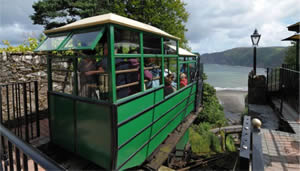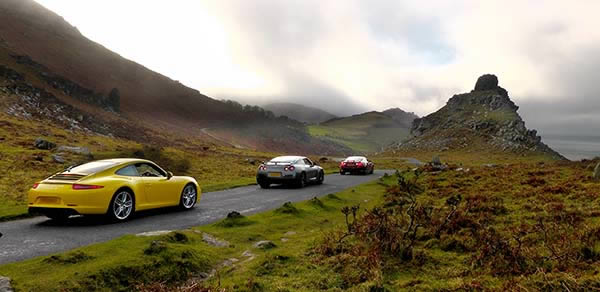 The small rural town of Lynton and coastal village of Lynmouth guarantee an escape to those wishing a complete change from the busy pace of modern life. It is impossible to rush in Lynton & Lynmouth. Set in the heart of Exmoor National Park the twin resorts are far from industry and commerce. It would be natural to assume that their appeal has relied solely on incomparable scenery and that that they have no claim to any remarkable happening in the past or indeed, the present. Take time to look a little closer, for they boast an impressive history that is not only diverse, but is surprising, fascinating, and most of all - notable.
The small rural town of Lynton and coastal village of Lynmouth guarantee an escape to those wishing a complete change from the busy pace of modern life. It is impossible to rush in Lynton & Lynmouth. Set in the heart of Exmoor National Park the twin resorts are far from industry and commerce. It would be natural to assume that their appeal has relied solely on incomparable scenery and that that they have no claim to any remarkable happening in the past or indeed, the present. Take time to look a little closer, for they boast an impressive history that is not only diverse, but is surprising, fascinating, and most of all - notable.
The following is a short introduction to some of the many interesting features of the resorts. Even a short visit is certain to impress, but it is suggested a stay of at least two days is needed to explore unique Lynton & Lynmouth. Surrounded by magnificent scenery, the setting of Lynton and Lynmouth on the North Devon coastline is unequalled by any resort on  England’s shore. The high ground of Exmoor falling to meet unusual ‘hog back’ cliffs that plunge steeply into the sea provide a breathtaking backdrop to the rural communities nestling below. The Lyn Rivers that tumble through deep wooded valleys as a series of small waterfalls meet at Lynmouth and flow across a rocky shore to the open sea. A small harbour flanked by the famous Rhenish Tower hints that a herring trade once sustained the community. The small town of Lynton originally supported by sheep farming, stands high on the cliff above its sister village.
England’s shore. The high ground of Exmoor falling to meet unusual ‘hog back’ cliffs that plunge steeply into the sea provide a breathtaking backdrop to the rural communities nestling below. The Lyn Rivers that tumble through deep wooded valleys as a series of small waterfalls meet at Lynmouth and flow across a rocky shore to the open sea. A small harbour flanked by the famous Rhenish Tower hints that a herring trade once sustained the community. The small town of Lynton originally supported by sheep farming, stands high on the cliff above its sister village.
Nearby, the magnificent Valley of Rocks opens out 450 ft above the sea to an elevated panorama of the Bristol Channel that is framed by the distant hills of South Wales. These spectacular and emotional views have drawn people to this remote area since the late 18th century. Even today, the resorts, set in the heart of Exmoor National Park are far from industry and commerce. In a rapidly changing world Lynton and Lynmouth have remained original and unspoilt for many years retaining an unrivalled position as the centre for discovering Exmoor.
The magnificent scenery around Lynton and Lynmouth reminded them of the continental views they were denied. Visits by Coleridge, Southey, and Wordsworth gave inspiration to these romantic poets and established the resorts credibility. Shelley and his young bride Harriet Westbrook honeymooned at Lynmouth in 1812. A new tourism industry had arrived for villagers that would eventually replace the meagre living they had derived from fishing and farming. R.D. Blackmore’s famous story of Lorna Doone was set in this area of Exmoor and continues to attract many visitors.
Pedestrian access between the resorts is by Westerway Path (Zig Zag) or by Clooneavin Path (steps to negotiate). As the paths are steep, use of the cliff railway should be considered, especially if travelling up from Lynmouth. As the larger of the twin resorts Lynton is the commercial centre where general stores, Post Office and bank are located. Lynmouth is also served by a Post Office. Both resorts are in a conservation area and have many attractive shops, restaurants, cafes and hotels that retain their Victorian or Edwardian character.
The Twin Towns of Lynton & Lynmouth
The twin town of Lynton & Lynmouth are situated on the North Devon coast approximately 18 miles East of Ilfracombe. Lynmouth with its picturesque Harbour is nestles below some of the highest sea cliffs in England. The East and West Lyn rivers, which wind their way to Lynmouth down the two Lyn valley’s have created some of the most spectacular scenery you could ever wish to find. These rivers were the cause of so much devastation during the flood of 1952, but now only seem to give pleasure and enjoyment to our many visitors each year. Lynmouth also has many Gift shops restaurants and pubs and for those, whom are a little more energetic some fantastic walks with views that will take your breath away.
Lynton which is perched high above Lynmouth (500ft), has its own Town Hall, Museum, Cricket ground, Tennis & Bowls Club and Football pitch, you will also find butchers, mini supermarkets, chemist, florist, fruit and veg, post office, newsagents and many gift shops. Just a short walk from Lynton centre you will find the Valley of Rocks and it’s famous goats, a great way to while away an afternoon or morning exploring all the footpaths, wildlife and fantastic views as far as the eye can see up and down the Bristol Channel. On a clear day you will even see the South Wales coast.
Connecting the twin villages is the Famous Lynton & Lynmouth Cliff Railway built by the Victorians. Still worked by water and opened over a hundred years ago, it was originally built to carry goods brought into harbour by ship and also tourists up to Lynton. Today it is a tourist attraction and plays an integral part of the economy of Lynton & Lynmouth carrying in excess of 300 thousand people each year.
 About the Area
About the Area